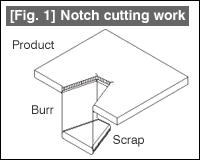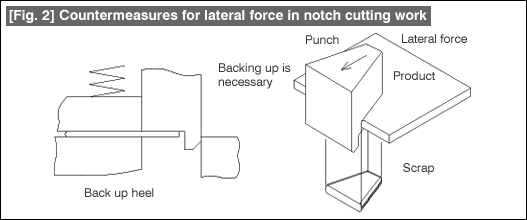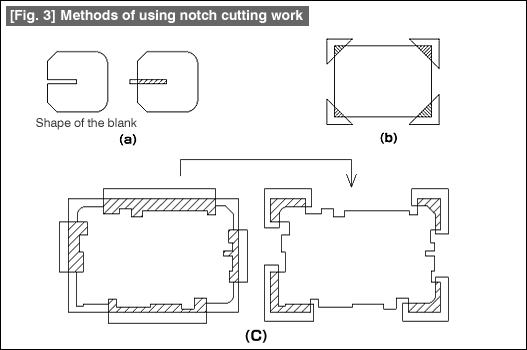#015 Basics of Blanking Work (5) Notch Cutting Work
Although notch cutting work is an unspectacular type of work, it is a method of working that is used extremely frequently. Please learn the features of this work.
| Figure 1 shows a notch. The setting of the dimensions of the notch cutting work is the same as in the hole punching work. The dimensions of the notch that is cut out are equal to the punch dimensions. Therefore, the clearance is taken on the die side. As can be seen from Fig. 1, the feature of the notch cutting work is that the entire periphery is not cut and there is a surface of the punch that does not take part in the cutting. This causes some problems. |  |
As is shown in Fig. 2, a lateral force (thrust load) acts on the punch. As a result, the clearance becomes widened which becomes a cause for burr generation. As a countermeasure for this, the punch is backed up. One such method is a back up heel. In the method for using the back up heel, before starting the work, the heel part is put inside the die, and when a lateral force acts, it is received by this part so that the punch does not move. As a countermeasure other than a back up heel, there is also the method in which the die side is made in the form of a projection and the lateral force is taken by that part. This method is called the back up block method. Even this is used for the same purpose. Either of these two methods is selected depending on the details of the work to be carried out.

Figure 3 shows some examples of using the notch cutting work. Fig. 3(a) shows a shape in which there is a slot (a notch with a narrow width is usually called a slot) in a part of the blank, and this shape causes the die to break in the part of the slot during blanking. In such situations, the blanking operation is done without the slot part, and a notch cutting operation is made in a separate process (this type of work may also be called slotting work). When there is a hole in the product, the notch cutting operation is combined with the hole punching work. Fig. 3(b) shows a frequently occurring case of carrying out the drawing operation of a rectangular shape from a cut length sheet (sketch material) in which problems in drawing are avoided by cutting the corners. The cutting of the corners in such situations is done by notch cutting work. (Some people may say that this is a type of cutting work because the cutting is made along a single straight line. This is a shape causing conflict between these two opinions.) Fig. 3(c) shows a different case. When the contour of a large shape is cut simultaneously (blanking or trimming, etc.), there may be problems in handling the scrap. In such situations, very often the work is done dividing it into several steps using notch cutting work as is shown in this figure. This is relatively more frequently used for work in the press lines using cut length sheets.

- #167 Problems in Punching and their Countermeasures (6) Scrap Processing in Punching
- #166 Problems in Punching and their Countermeasures (5) Trimming of Drawn and Shaped Parts
- #165 Problems in Punching and their Countermeasures (4) Scrap Clogging in Punching
- #164 Problems in Punching and their Countermeasures (3) Bending and Twisting of Narrow Punched Parts
- #163 Problems in Punching and their Countermeasures (2) Bending due to Punching



